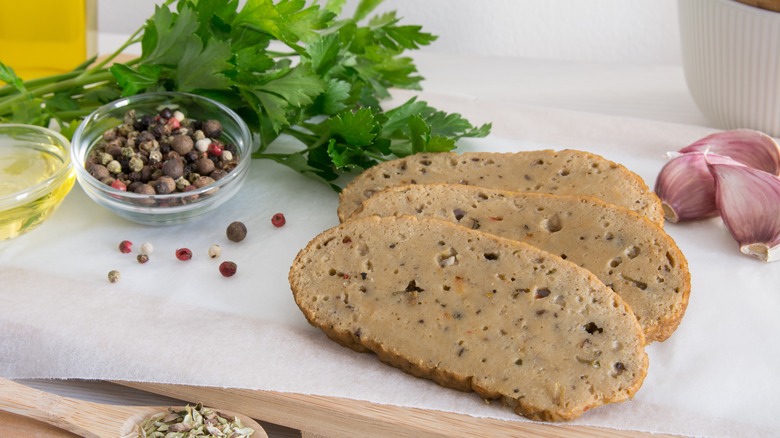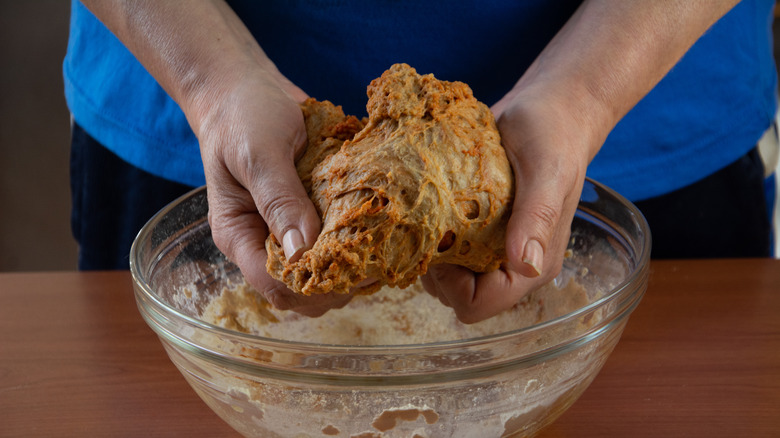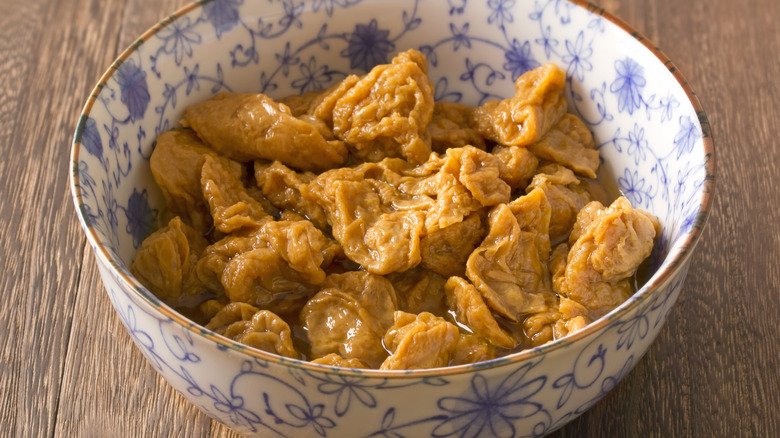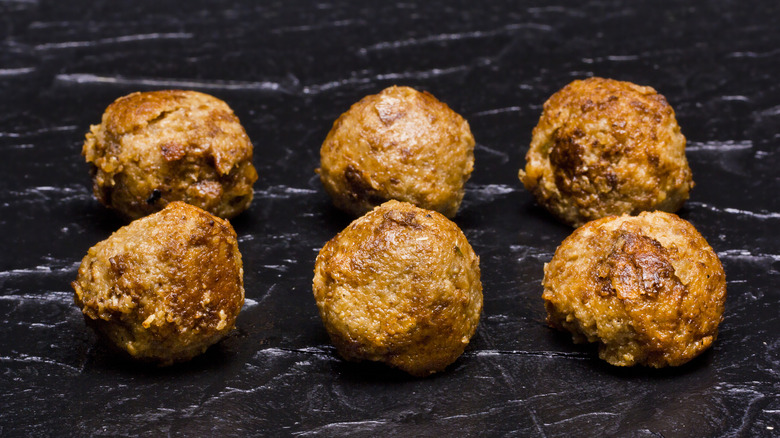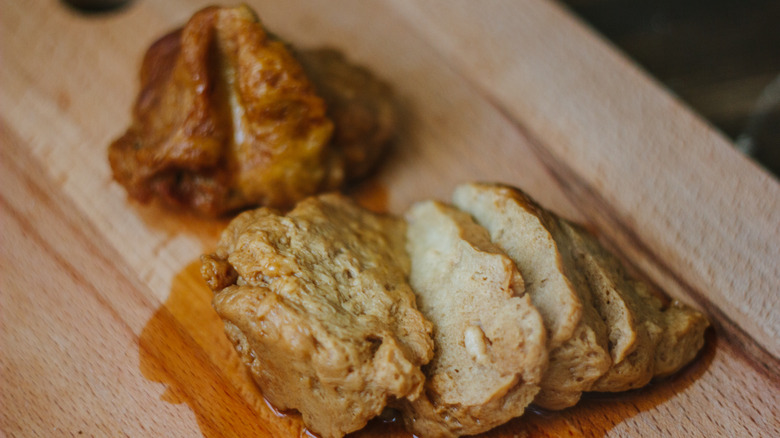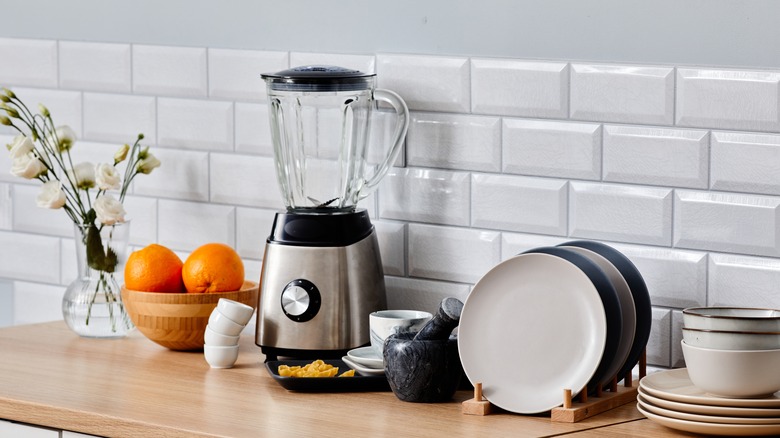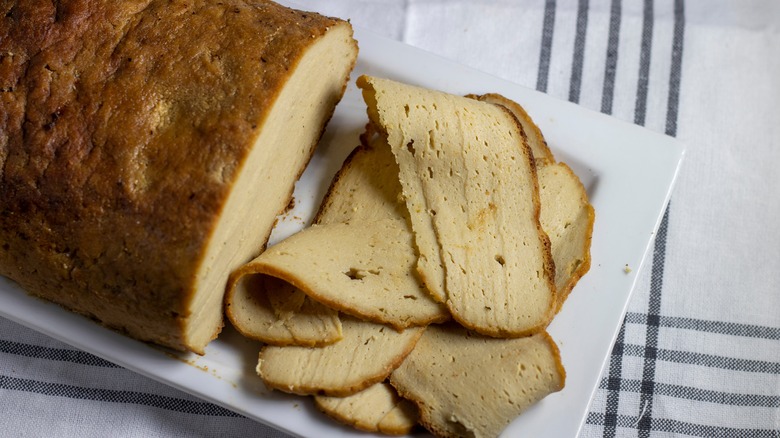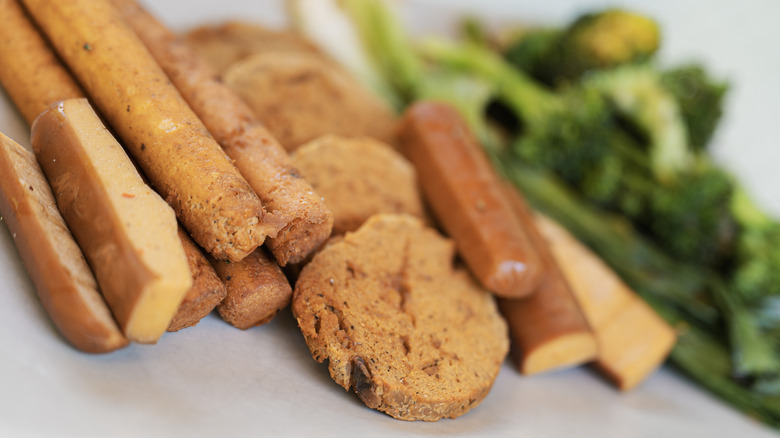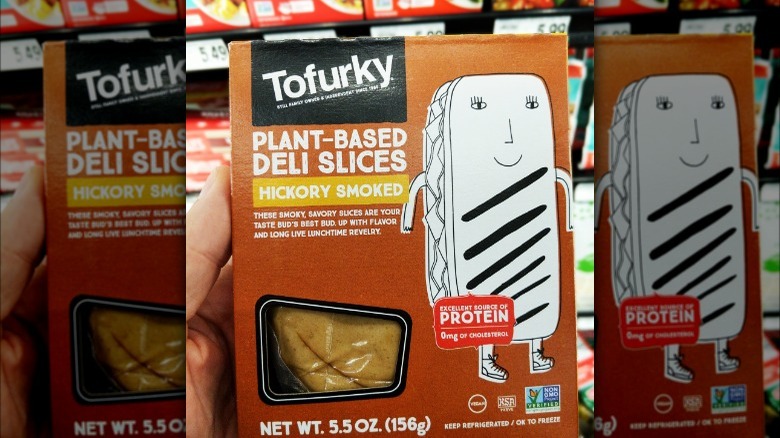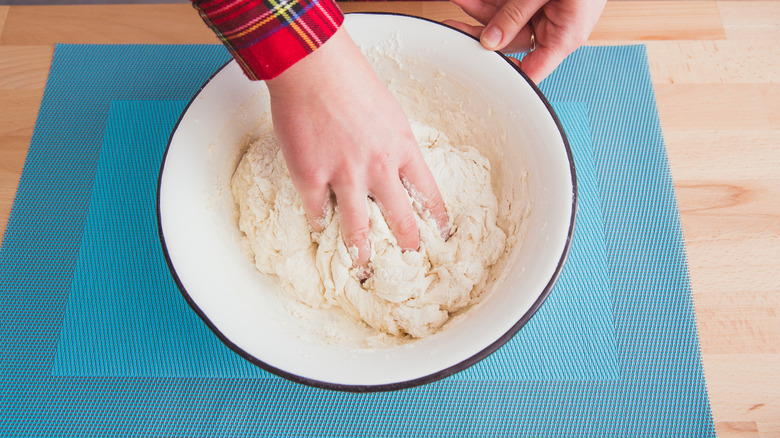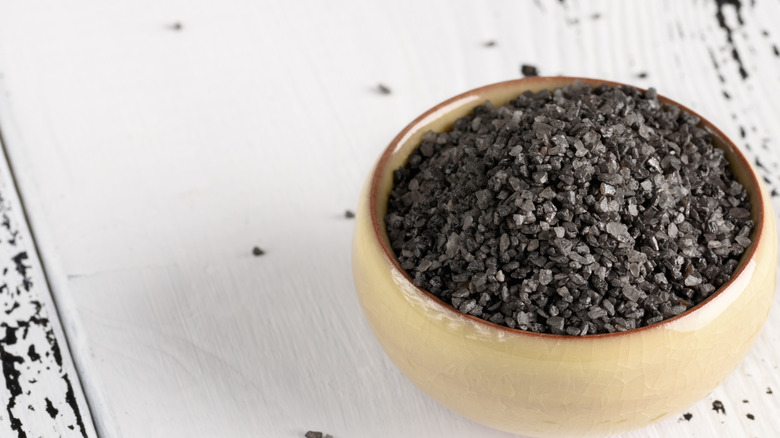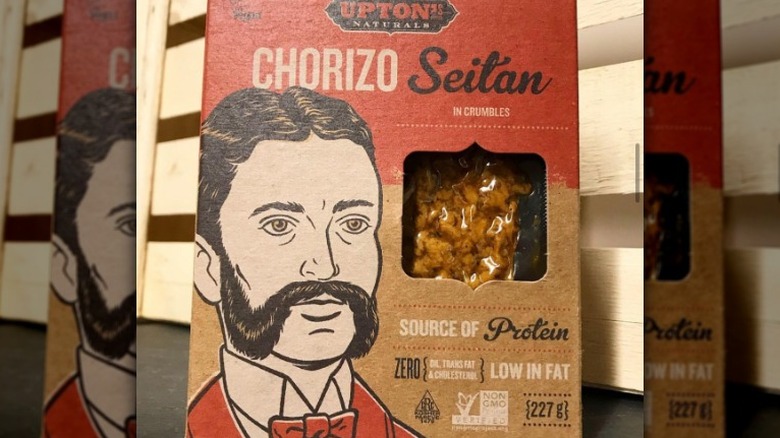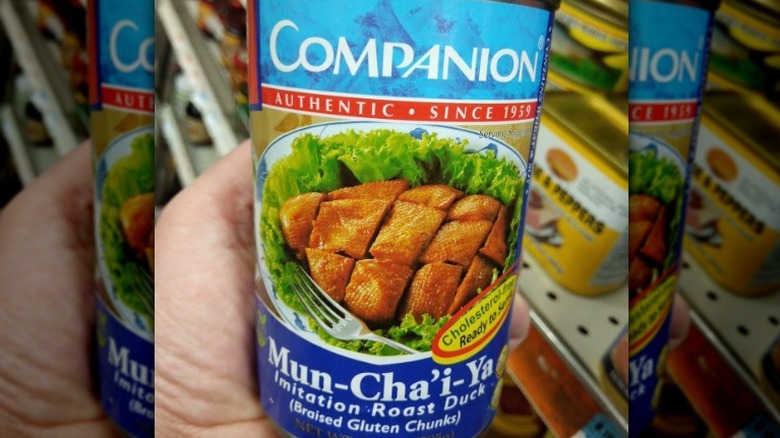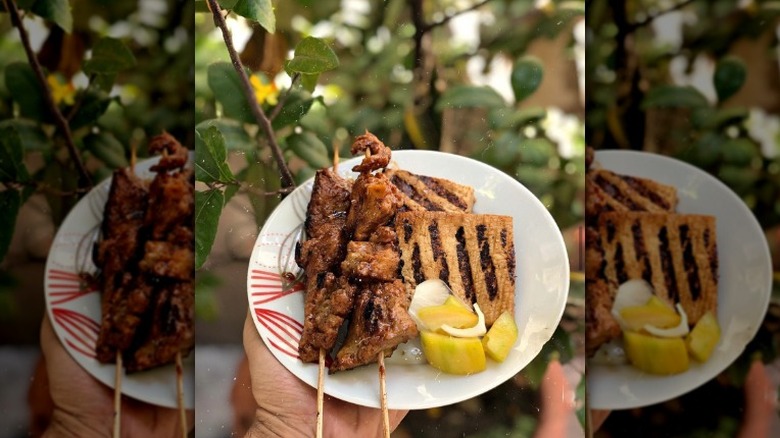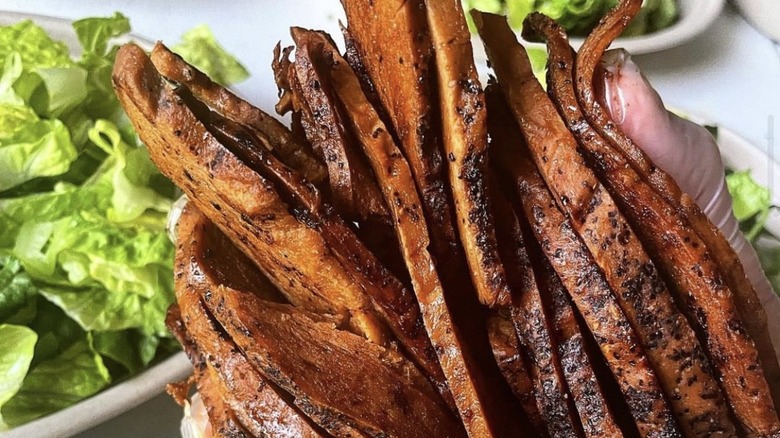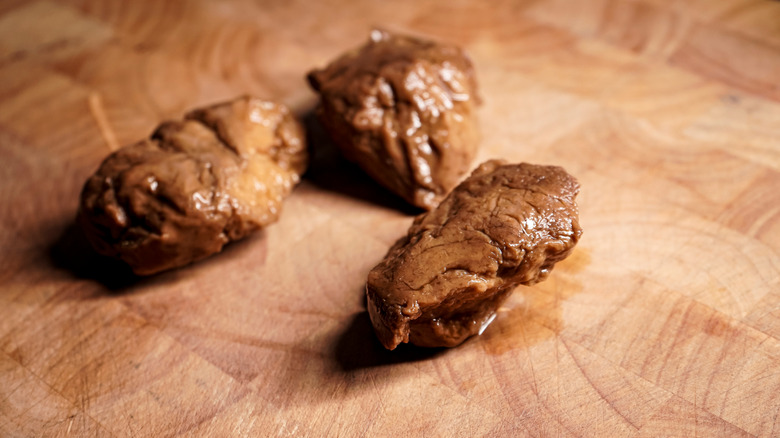Everything You Need To Know About Seitan
We may receive a commission on purchases made from links.
The punchline of "so where do vegans get their protein?" is a moot one at this point in culinary history. The rise of plant-based food engineering and popular brands like Impossible Foods and Beyond Meat have triggered increased public investment in plant-based meats. Although some of these foods, like burgers that "bleed" when you bite into them, seem somewhat futuristic, all of these products are built on simple, plant-based foods that have been around for centuries — many of which have been enhanced with new flavors, textures, and modern technology.
Seitan (pronounced "say-tan"), like tofu, is one meat alternative integrated into many processed vegan meats. Although the name might suggest something nefarious, seitan is one of the most high-quality protein sources for vegans. It is also often recognized as one of the most meat-like vegan proteins because of its stringy, meat-like texture. Here are some of the most important things you need to know about seitan and how you can make it at home yourself.
Seitan was initially created in China
According to Love Seitan, this alternative protein dates back almost 1,500 years in China. Buddhist monks, recognized as one of the first societies to adopt meat-free diets, quickly learned to soak wheat dough in water to remove the starch and cook the residual protein as they would meat. Seitan evolved through the years and was eventually brought to Western cultures in the 1960s. George Ohsawa, a Japanese philosopher, was the first to coin the name "seitan," which is derived from the Japanese words for "made of" (sei) and "protein" (tanpaku).
Seitan grew in popularity thanks to the rise of macrobiotic diets in the United States. This diet conceptually enforced eating in harmony with nature, thus abstaining from eating meat, dairy, animal products, and processed foods. As a result, seitan could provide high levels of protein and the same texture as meat — just without the ethical complications of eating animals.
Seitan is made from vital wheat gluten
The critical ingredient in seitan is vital wheat gluten. We should first note that seitan and vital wheat gluten are not the same things; you cannot substitute seitan for a recipe requiring vital wheat gluten. In essence, vital wheat gluten is like isolated gluten proteins. This gives the seitan its stringiness and elastic qualities. You can also use vital wheat gluten to add stretchiness to bread or transform your all-purpose flour into bread flour.
If you plan on making seitan at home, there are two potential avenues for getting your vital wheat gluten. The first is to purchase a bag of vital wheat gluten from an online retailer or a health foods grocer. The second is to do the same as the ancient monks did — wash your flour to remove the starches. The wash-the-flour method uses three parts of flour (bread or all-purpose) to one part of water. Then, the ball is washed for up to 12 hours — depending on how chewy you want the seitan. Seitan that has not been washed for too long will be softer and chewier, while seitan that has been washed too much will have the texture of rubber tires.
It can be mixed with other vegan proteins to improve its texture
After you've developed your seitan dough, you can start mixing it with other ingredients to help build its flavor — since seitan tastes like wet flour on its own. We recommend cutting the dough with a pureed bean paste to help reduce its elasticity and make it softer. You can add many types of beans; we recommend using cannellini beans for their silky texture and a mild taste. To add beans to your seitan, puree the beans (with their aquafaba juice) in a blender or a food processor with a bit of stock or water before kneading them into your wheat gluten.
Other recipes for chicken-alternative seitan call for tofu as a cutting agent. Soft or silken tofu blends easily when mixed with the other ingredients and doesn't have a robust flavor. The tofu helps mimic the tenderness of the chicken — meaning that you can alter the ratio of tofu to vital wheat gluten if you're looking for chewier meat like vegan carne asada.
You need to steam seitan before you can cook it
Steaming is vital to ensure your seitan is soft and ready to cook. Some recipes recommend baking the seitan or boiling it in stock rather than steaming, but steaming is the most widely accepted way to prepare seitan. Steaming seitan gives it a meaty, chewy, and soft texture. Boiling seitan makes the protein too spongy because water can infiltrate the loaf, while baking makes the surface dry and rubbery.
Depending on the recipe, you'll only need to steam your seitan for between 10 and 15 minutes to get a perfectly soft texture. Some recipes will call for leaving the entire loaf of seitan whole and wrapping it in foil or cheesecloth to steam, while others will ask you to cut up the pieces small before adding them to a steaming pot. If you're cooking a whole loaf, allow the loaf to rest before slicing to ensure the best possible texture.
It can break your blender or food processor
Blenders and food processors are great tools for any cook to have in their home kitchen. But making the deadly mistake of mixing your vital wheat gluten in a blender or a food processor can cause your machine motor to go into overdrive and break. You'll need a high-powered, reputable machine if you want it to be able to knead vital wheat gluten — but there's a risk of breaking the device.
Instead, you can use a high-powered blender to mix your seasonings and cutting agents into a puree. Then, you can pour the purée into a separate bowl and mix your vital wheat gluten in. You'll still get the smoothness of the purée but without sacrificing a blender in the process. Alternatively, you can use a stand mixer with a dough hook attachment to help knead together your ingredients. If you go this route, you'll need to listen and watch your machine for signs of overworking and motor burnout.
You can't make it gluten free
Seitan is made with vital wheat gluten. You can't replicate the exact texture of seitan without using this critical ingredient — which is also a potential allergen for many folks. People with Celiac disease, gluten allergies, or gluten intolerances should avoid consuming seitan or processed food containing seitan.
If you don't eat gluten, there are other meat alternatives you can choose from. Tofu, which only contains soy allergens, can resemble a meaty texture with a simple step — freezing it. Since tofu has nearly 80% water, freezing a whole block of tofu means the water will turn to ice crystals in a few hours. Placing the tofu in the refrigerator afterward will draw out the ice and leave lots of holes in the tofu — which in turn means a spongier texture when you marinate or cook it. You can use this frozen tofu replacement for seitan to make homemade vegan nuggets.
There are many health benefits associated with eating seitan
Eating seitan regularly carries numerous health benefits, according to Healthline. Seitan has nearly the same amount of protein as beef loin, with fewer calories and less fat. It also contains slightly more carbohydrates than beef loin.
Seitan is a good source of protein for plant-based eaters compared to other plant-based proteins. A ¼ cup of vital wheat gluten has 21 grams of protein, compared to the same amount of firm tofu, which has 5 grams of protein (via the USDA). Pre-made seitan may contain high sodium levels, so if you're conscious of your sodium intake that's something to keep in mind.
Unlike animal-based proteins, seitan is not a complete protein — meaning it does not contain enough of all the amino acids needed to build a whole protein. People who eat seitan need to ensure they are getting lysine from other foods in their diet to make up for this difference — such as beans, soy, and lentils (via Healthline).
Seitan can be used as a binder in processed vegan meat alternatives
If you've eaten certain processed plant-based meats before, you've likely had seitan. The elastic, spongy quality of the meat is perfect for mimicking the texture of real meat in foods like vegan sausage and plant-based burgers. Field Roast vegan sausage, one of our favorite plant-based sausage brands, is made with vital wheat gluten, eggplant, onions, and flavoring agents. It's the perfect pairing for pasta or a veganized version of a sausage and pepper sandwich.
Other products that contain vital wheat gluten include the Tofurky deli slices. These thin sheets of vegan meat come in flavors like smoked ham, peppered, and oven roasted. You can use these slices of Tofurky in your next wrap or club sandwich. The brand's famous roasts are also made with vital wheat gluten and tofu; you can include these as a replacement for turkey at your next Thanksgiving dinner.
The amount of time you knead your seitan will alter its texture
The amount of time you spend kneading your seitan will develop its gluten strands to different extents — just like with bread. For a standard mixture of chickpea flour and vital wheat gluten, we recommend kneading the seitan for five minutes before allowing it to rest for another five minutes. The resting period is critical for working with seitan because it allows the gluten to slack a little bit, making rolling and shaping easier.
If you want to try making seitan shreds, you'll want to knead the loaf until the shreds become visible in the gluten. This might take over 10 minutes to develop, so if you're going to save your arm muscles from a workout, we recommend pulling out your dough hook and your stand mixer. At first, the gluten may start to crumble — you can add a splash of water to help hydrate your dough as it's being kneaded. After your dough is steamed, you'll find the texture of the shreds to be much more similar to shredded chicken breasts.
There are several ingredients you can use to flavor seitan
Seitan has a neutral taste, so adding flavoring agents can help make this meat alternative a little more palatable. There are two ways to add flavoring to your seitan — by adding the ingredients directly to the dough or adding it to the water you steam your loaf with. We recommend the former because it is more likely to infuse the flavors into the dough.
One of the popular ingredients you'll see added to seitan is nutritional yeast. This yellow powder comes from the deactivated saccharomyces cerevisiae yeast and has a mild, cheesy flavor akin to parmesan. The nutritional yeast can bring an umami flavor to the seitan and a whole host of B vitamins. You can also add black salt to your seitan. It's an ingredient used often for vegan recipes because of its sulfuric, egg-like flavor. However, despite its name, black salt doesn't contain much sodium compared to table salt, so you'll have to add some salty ingredients like soy sauce or liquid aminos to lend a hand on the salty flavor front.
You can purchase pre-made seitan if you don't want to make your own
The thought of making your own seitan can be a bit daunting. Luckily, several brands offer pre-made seitan you can experiment with. For example, Upton's Naturals sells vacuum-sealed seitan in several flavors, including original, chorizo, Italian-seasoned, and ground seitan. We recommend using the chorizo-flavored seitan as a filling for your next taco night and the Italian-seasoned seitan for a high-protein pasta topping.
Sweet Earth is another popular seitan manufacturer. You can purchase seitan strips in both original and chipotle-style, along with seitan slices. We recommend using the slices for a vegan take on a Philly cheesesteak. These slices are a bit meatier in flavor than the Tofurky deli slices, with a texture and taste that resembles thinly sliced beef. Sweet Earth also offers a breakfast favorite — Benevolent Bacon. It's made with seitan, buckwheat flour, and kidney beans flavored with hickory, nutritional yeast, garlic, soy sauce, and other aromatics. While the texture doesn't exactly resemble bacon, the hickory flavor is the perfect accompaniment for your breakfast favorites like pancakes or eggs.
Canned seitan is available at some grocery stores
Many Asian cultures still enjoy seitan, so it's expected to see seitan sold at many Asian grocery stores and markets. You can buy canned seitan at these stores or online retailers like Amazon. Cha'i Pow Yu is Chinese braised seitan packaged in a salty, aromatic broth. Once you've removed the seitan chunks from the can, you can add the pieces to your stir fry or ramen.
Another canned seitan product is sold under Mun Cha'i Ya – Peking vegetarian roasted duck. When you remove the top of the can, you'll find that the exterior texture of the seitan is covered with a plucked duck appearance. The broth is also much more flavorful than Cha'i Pow Yu because it often contains MSG and soy sauce for flavor. To prepare this seitan product, you'll need to fry it in oil to help crisp up the edges; it is not meant to be eaten straight out of the can. Instead, you can add this mock duck to curries or serve it with stir-fried vegetables.
Grill or roast seitan for crispy edges
Seitan has a rubbery texture, but it will still be able to crisp under the right conditions. If you plan to grill your seitan, we recommend first marinating it with seasonings like soy sauce, oil, lime juice, and Dijon mustard to develop a meat-like flavor. Adding liquid smoke can further enhance fresh-from-the-grill flavors — make sure only to add a few drops, because it can easily overpower the other marinade ingredients. Like meat, you should allow your seitan to marinate for a few hours before firing up your grill.
Seitan takes less time to grill than other meat substitutes would. Depending on the heat of your grill, you'll only have to cook the seitan for about five minutes on each side to get grill marks. And since there's no risk of contamination from raw ingredients, you can brush your marinade on the seitan as it's grilling for more flavor. Finally, serve your finished slices on kebabs with salad, fresh grains, or roasted vegetables.
It can make a delicious vegan bacon
If you've gone vegetarian or vegan at any point, you can probably remember how devastating it was that you couldn't eat bacon anymore. And while we can't promise that the texture of seitan bacon will be 100% pork-like, you can play with the marinade flavors to add more bacon-like notes. After you've steamed and rested your seitan loaf, cut it into thin strips. A mandolin or a sharp knife are two tools that can be used for this critical step — it will make your seitan more crispy and bacon-like. Then, place your strips into a marinade with ingredients like soy sauce, tomato paste, liquid smoke, high smoke-point oil (like grapeseed oil), and garlic powder. Next, fry the bacon in a shallow pan with another splash of oil until crispy on both sides.
You can use other replacements for seitan bacon if you have a gluten allergy. For example, rice paper, carrots, and even banana peels can be baked into thin breakfast accompaniments.
You can freeze seitan if you plan on using it for later
If you're going through the arduous process of making seitan at home, you should make enough to last a while. To properly store your seitan, you should place the seitan in air-tight storage containers with a splash of broth to keep the seitan in. It will last in the fridge for up to 10 days or in the freezer for upwards of six months. We recommend taking the seitan out of the freezer or fridge and simmering it in its broth for 10 minutes twice a week to help the loaf maintain its flavor.
You can dry store your seitan by adequately cooking it, wrapping it in plastic or tin foil, and storing it in the refrigerator for up to five days. We also suggest double wrapping your seitan loaf to prevent refrigerator odors from tainting the taste of your seitan.
